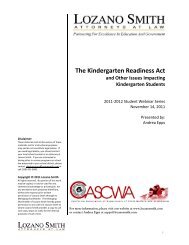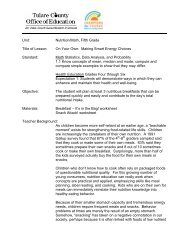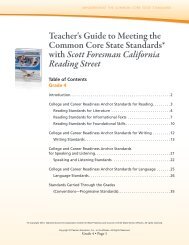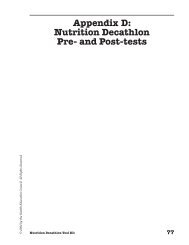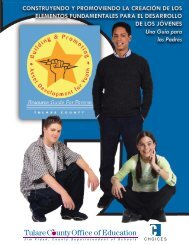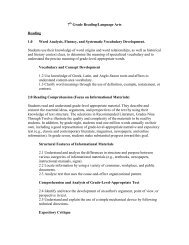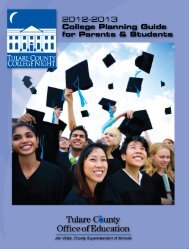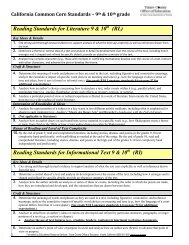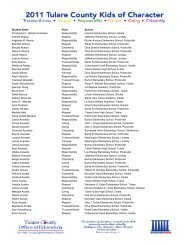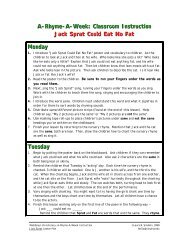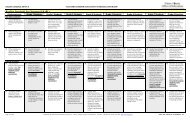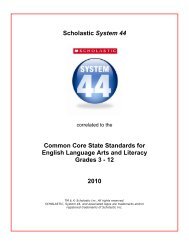CCCS K-5 ELA Continuum - Tulare County Office of Education
CCCS K-5 ELA Continuum - Tulare County Office of Education
CCCS K-5 ELA Continuum - Tulare County Office of Education
- No tags were found...
You also want an ePaper? Increase the reach of your titles
YUMPU automatically turns print PDFs into web optimized ePapers that Google loves.
ENGLISH LANGUAGE ARTS K‐5 “CALIFORNIA COMMON CORE CONTENT STANDARDS CONTINUUM”Speaking & Listening Standards K-5 (SL)Kindergartners: Grade 1 Students Grade 2 Students Grade 3 Students Grade 4 Students Grade 5 StudentsComprehension & Collaboration1. Participate in collaborative conversationswith diverse partners about Kindergartentopics and texts with peers and adults insmall and larger groups.a. Follow agreed-upon rules fordiscussions (e.g., listening toothers and taking turns speakingabout the topics and texts underdiscussion).b. Continue a conversation throughmultiple exchanges.2. Confirm understanding <strong>of</strong> a text read aloudor information presented orally or throughother media by asking and answeringquestions about key details and requestingclarification if something is notunderstood.a. Understand and follow one-andtwo-step oral directions.3. Ask and answer questions in order to seekhelp, get information, or clarify somethingthat is not understood.Presentation <strong>of</strong> Knowledge & Ideas4. Describe familiar people, places, things,and events and, with prompting andsupport, provide additional detail.1. Participate in collaborative conversationswith diverse partners about grade 1 topicsand texts with peers and adults in small andlarger groups.a. Follow agreed-upon rules fordiscussions (e.g., listening to otherswith care, speaking one at a time aboutthe topics and text under discussion).b. Build on others’ talk in conversationsby responding to the comments <strong>of</strong>others through multiple exchanges.c. Ask questions to clear up confusionabout the topics and texts underdiscussion.2. Ask and answer questions about keydetails in a text read aloud or informationpresented orally or through other media.a. Give, restate, and follow simpletwo-step directions.3. Ask and answer questions about what aspeaker says in order to gather additionalinformation or clarify something that is notunderstood.4. Describe people, places, things, and eventswith relevant details, expressing ideas andfeelings clearly.a. Memorize and recite poems,rhymes, and songs with expression.1. Participate in collaborative conversationswith diverse partners about grade 2 topicsand text with peers and adults in small andlarger groups.a. Follow agreed-upon rules fordiscussions (e.g., gaining the floor inrespectful ways, listening to otherswith care, speaking one at a time aboutthe topics and texts under discussion).b. Build on others’ talk in conversationsby linking their comments to theremarks <strong>of</strong> others.c. Ask for clarification and furtherexplanation as needed about the topicsand texts under discussion.2. Recount or describe key ideas or detailsfrom a text read aloud or informationpresented orally or through other media.a. Give and follow three- and foursteporal directions.3. Ask and answer questions about what aspeaker says in order to clarifycomprehension, gather additionalinformation, or deepen understanding <strong>of</strong> atopic or issue.4. Tell a story or recount an experience withappropriate facts and relevant, descriptivedetails, speaking audibly in coherentsentences.a. Plan and deliver a narrativepresentation that: recounts a wellelaboratedevent, includes details,reflects a logical sequence, andprovides a conclusion.1. Engage effectively in a range <strong>of</strong>collaborative discussions (one-on-one, ingroups, and teacher led) with diversepartners on grade 3 topics and texts,building on others’ ideas and expressingtheir own clearly.a. Come to discussions prepared havingread or studied required material;explicitly draw on that preparation andother information known about thetopic to explore ideas under discussion.b. Follow agreed-upon rules fordiscussions (e.g., gaining the floor inrespectful ways, listening to otherswith care, speaking one at a time aboutthe topics and texts under discussion).c. Ask questions to check understanding<strong>of</strong> information presented, stay on topic,and link their comments to the remarks<strong>of</strong> others.d. Explain their own ideas andunderstanding in light <strong>of</strong> thediscussion.2. Determine the main ideas and supportingdetails <strong>of</strong> a text read aloud or informationpresented in diverse media and formats,including visually, quantitatively, andorally.3. Ask and answer questions aboutinformation from a speaker, <strong>of</strong>feringappropriate elaboration and detail.4. Report on a topic or text, tell a story, orrecount an experience with appropriatefacts and relevant, descriptive details,speaking clearly at an understandable pace.a. Plan and deliver aninformative/explanatorypresentation on a topic that:organizes ideas around majorpoints <strong>of</strong> information, follows alogical sequence, includessupporting details, uses clear andspecific vocabulary, and provides astrong conclusion.1. Engage effectively in a range <strong>of</strong>collaborative discussions (one-on-one, ingroups, and teacher led) with diversepartners on grade 4 topics and texts,building on others’ ideas and expressingtheir own clearly.a. Come to discussions prepared havingread or studied required material;explicitly draw on that preparation andother information known about thetopic to explore ideas under discussion.b. Follow agreed-upon rules fordiscussions and carry out assignedroles.c. Pose and respond to specific questionsto clarify or follow up on information,and make comments that contribute tothe discussion and link to the remarks<strong>of</strong> others.d. Review the key ideas expressed andexplain their own ideas andunderstanding in light <strong>of</strong> thediscussion.2. Paraphrase portions <strong>of</strong> a text read aloud orinformation presented in diverse media andformats, including visually, quantitatively,and orally.3. Identify the reasons and evidence aspeaker or media source provides tosupport particular points.4. Report on a topic or text, tell a story, orrecount an experience in an organizedmanner, using appropriate facts andrelevant, descriptive details to supportmain ideas or themes; speak clearly at anunderstandable pace.a. Plan and deliver a narrativepresentation that: relates ideas,observations, or recollections;provides a clear context; andincludes clear insight into why theevent or experience is memorable.1. Engage effectively in a range <strong>of</strong>collaborative discussions (one-on-one, ingroups, and teacher- led) with diversepartners on grade 5 topics and texts,building on others’ ideas and expressingtheir own clearly.a. Come to discussions prepared havingread or studied required material;explicitly draw on that preparation andother information known about thetopic to explore ideas under discussion.b. Follow agreed-upon rules fordiscussions and carry out assignedroles.c. Pose and respond to specific questionsby making comments that contribute tothe discussion and elaborate on theremarks <strong>of</strong> others.d. Review the key ideas expressed anddraw conclusions in light <strong>of</strong>information and knowledge gainedfrom the discussions.2. Summarize a written text read aloud orinformation presented in diverse mediaand formats, including visually,quantitatively, and orally.3. Summarize the points a speaker ormedia source makes and explain howeach claim is supported by reasons andevidence, and identify and analyze anylogical fallacies.4. Report on a topic or text or present anopinion, sequencing ideas logically andusing appropriate facts and relevant,descriptive details to support main ideas orthemes; speak clearly at an understandablepace.a. Plan and deliver an opinion speechthat: states an opinion, logicallysequences evidence to support thespeaker’s position, uses transitionwords to effectively link opinionsand evidence (e.g., consequentlyand therefore), and provides aconcluding statement related to thespeaker’s position.b. Memorize and recite a poem orsection <strong>of</strong> a speech or historicaldocument using rate, expression,and gestures appropriate to theselection.Page 7 <strong>of</strong> 15 Formatted by <strong>Education</strong>al Resource Services, <strong>Tulare</strong> <strong>County</strong> <strong>Office</strong> <strong>of</strong> <strong>Education</strong>, Visalia, California (559) 651‐3031 www.tcoe.org/ers/ *BOLD INDICATES CALIFORNIA’S 15%



